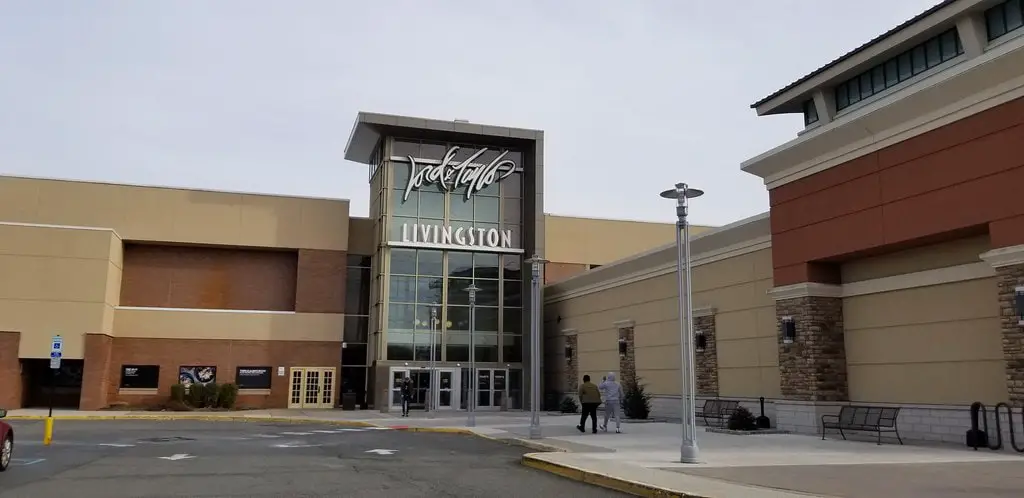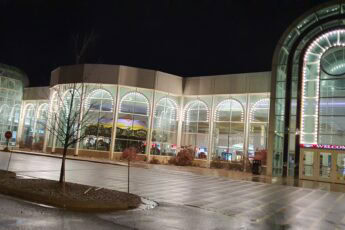Livingston Mall: Planning and Launch in the Early 1970s
Developers began planning Livingston Mall in the late 1960s. N. K. Winston Corp. led the project, targeting the suburban population in Northern New Jersey and aiming to capitalize on the growing demand for suburban shopping centers. Located near the Passaic River and accessible via major highways, the mall’s strategic placement aimed to attract customers from Essex, Morris, and Union counties.
The first phase of Livingston Mall opened in 1971 with the launch of a Bamberger’s department store. This store, a division of R.H. Macy & Co., already had a strong presence in the region. Bamberger’s opening set the stage for the mall’s full launch in 1972.
By then, additional anchor stores, including Sears, M. Epstein, and Hahne & Company, had joined the mall’s roster. Sears had previously operated a store in Newark’s South Ward, and its move to Livingston reflected the broader shift of retail activity to suburban locations.
The mall’s development paralleled the decline of downtown Newark as a retail hub. The Newark race riots in July 1967 accelerated the exodus of shoppers and stores from the city.
Both Bamberger’s and Hahne & Co. maintained flagship stores in downtown Newark but recognized the need to expand into suburban areas to retain their customer base.
Livingston Mall’s early success reflected broader trends in commercial real estate and retail. Developers focused on creating accessible, comprehensive shopping experiences for the growing suburban population.
The mall included over 968,000 square feet of retail space, making it one of the largest in the region at the time. By catering to the needs of suburban families, Livingston Mall quickly became a preferred destination for things to do in Livingston, NJ.
Livingston Mall’s Prime Retail Era
In the 1970s and 1980s, Livingston Mall stood out as a key retail destination in Northern New Jersey. I saw the rise of many malls during this period, but Livingston Mall held its own by offering a mix of stores that appealed to the growing suburban population.
The presence of strong anchor stores like Sears, Bamberger’s (later Macy’s), and Hahne & Company drew in steady foot traffic. These stores provided a wide range of products, from clothing to home goods, making the mall a convenient one-stop shopping experience.
Macy’s, which replaced Bamberger’s in 1986, quickly became a cornerstone of the mall. Lord & Taylor took over the Hahne & Company space in 1985, adding a touch of upscale retail to the mall’s offerings. The M. Epstein store also adapted to the evolving retail landscape by converting into an annex for Macy’s.
During these years, Livingston Mall expanded its range of services. New stores opened, offering everything from fashion and electronics to dining options.
The mall wasn’t just about shopping; it became a place where people spent their weekends, whether grabbing a meal or catching up with friends.
The layout of the mall, with two levels of shops, made it easy for visitors to explore the different stores without feeling overwhelmed. By the late 1980s, Livingston Mall had firmly established itself as a retail hub in the region.

Adaptation and Challenges in the Late 20th Century
As the 1990s approached, Livingston Mall faced new challenges. The retail industry began to shift with the rise of big-box stores like Walmart and Target. These stores offered similar products at lower prices, drawing customers away from traditional malls.
One of the first signs of this shift was the closure of some smaller stores. As leases ended, not all businesses chose to renew, and the mall began to see a few empty storefronts. The big-name anchors like Macy’s and Lord & Taylor remained, but the variety of smaller shops started to dwindle.
By the late 1990s, the mall’s struggle to maintain its former glory became apparent. New shopping centers and the continued rise of big-box retailers only added to the pressure.
Livingston Mall, once a vibrant retail destination, now had to fight to keep its place in an increasingly crowded market.
The Digital Shift and Decline in the Early 2000s
The 2000s brought a major shift in how people shopped. Online shopping started to gain traction, and traditional malls like Livingston began to feel the impact.
Amazon and other e-commerce giants started offering the convenience of shopping from home, which began to change consumer habits in a big way. This shift hit brick-and-mortar stores hard, and Livingston Mall was no exception.
Foot traffic started to decline, and stores that once thrived began to close their doors. By 2020, Sears, one of the mall’s original anchor stores, announced it would shut down as part of its broader plan to reduce its physical presence. This closure marked a turning point for the mall, signaling the end of an era.
The COVID-19 pandemic in 2020 only worsened the situation. The pandemic accelerated the decline of physical retail spaces as more people turned to online shopping for safety and convenience.
In August 2020, Lord & Taylor, another anchor, closed its doors as part of the company’s decision to exit brick-and-mortar retail altogether.

Redevelopment Efforts and Uncertain Future
In 2021, Livingston Township authorized a redevelopment study for the mall property. The study considered various possibilities, including transforming the mall into a mixed-use development with residential units, offices, and public spaces.
This idea wasn’t unique to Livingston; many malls across the country were undergoing similar transformations.
However, despite these efforts, the mall’s future remained uncertain. Kohan Retail Investment Group, the mall’s owner, is known for buying struggling malls. While they expressed interest in redevelopment, there hasn’t been much progress.
The mall continues to operate, but with many vacant stores and a dwindling number of shoppers, it’s hard to see how it can return to its former glory.
The community’s response to these changes has been mixed. Some people see the redevelopment as a positive step forward, a way to utilize the large, underutilized space.
Others feel a sense of loss, remembering the mall as it was in its heyday. The idea of turning the mall into something other than a shopping center reflects how much retail has changed over the years.
Ownership Challenges and Uncertain Future for Livingston Mall
In 2023 and 2024, Livingston Mall continues to face a challenging path forward, largely due to complications surrounding its ownership and redevelopment prospects.
As the mall’s condition deteriorates, with numerous vacancies and dwindling foot traffic, the community and local government are increasingly frustrated by the lack of clear progress.
Recent reports from early 2024 indicate that the mall’s redevelopment has been slowed by its complex ownership structure. The unwillingness to invest in revitalization efforts has made it difficult for the mall to attract new businesses or even maintain existing ones.
Kohan Retail Investment Group has faced criticism for its handling of the property, with many in the community feeling that the company has not committed the necessary resources or attention to turn the mall around.

In response to these concerns, Livingston Township officials have been vocal about the difficulties in moving forward with redevelopment plans. There are many issues, from negotiating with the current owners to addressing community needs and market realities.
Despite these challenges, there have been discussions about potential changes to the mall’s structure and purpose, including converting parts of it for non-retail uses such as residential units or community spaces.
Meanwhile, the contrast between Livingston Mall and nearby shopping centers, like The Mall at Short Hills, has become increasingly stark.
While Short Hills has successfully attracted new stores and maintained its status as a premier shopping destination, Livingston Mall has struggled to remain viable.
In summary, Livingston Mall’s future remains uncertain. The coming months will be crucial as the township, and the owners attempt to find a way forward that can satisfy both business interests and community needs.









get boscov’s to go in there or dillards they would do great in livingston mall
Great idea! Boscov’s or Dillard’s would be a fantastic addition to Livingston Mall. Here’s hoping the management takes note. Thanks for the suggestion.